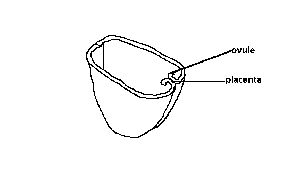JAMB - Biology (1995 - No. 21)

The type of placentaion shown is
Explanation
Axile placentation is a type of ovule arrangement where ovules are attached to a central, fleshy column within a multi-locular ovary, with partitions (septa) separating the chambers (locules).
Marginal placentation is a type of placentation in which the placenta forms a ridge along the ovary wall, and ovules develop in rows on the ridge.
Parietal placentation is a type of placentation where ovules are attached to the inner wall of the ovary, specifically on the edges of fused carpels, and is commonly found in plants like melons and mustard.
In free central placentation, ovules are borne on a central column within a single-chambered ovary, without partitions connecting the column to the ovary wall, as seen in plants like Dianthus and Primrose.
Comments (0)


